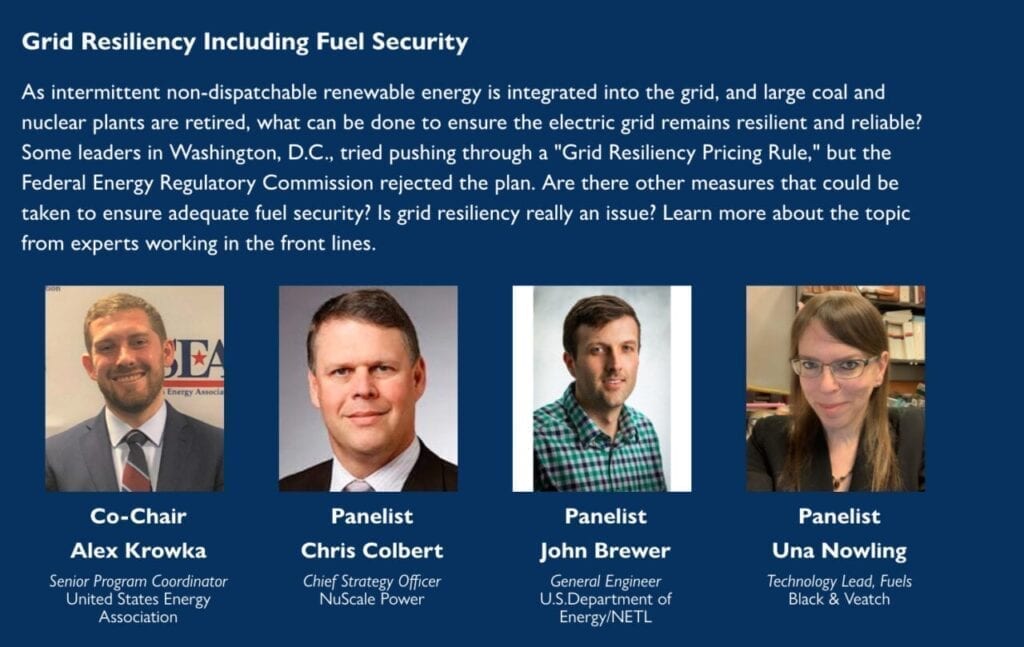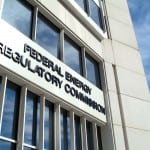The U.S. power industry lacks forward-looking ways to measure grid resiliency and traditional reliability metrics could become irrelevant as more intermittent generation inundates the bulk power system. But rather than continually looking backward to learn from ever-increasing emergencies or close-shaves, power system operators must work to cultivate a balanced portfolio that considers all aspects of the bulk power system, from generation through end-use.
That was the premise of a discussion by three power experts: John Brewer, general engineer at the Department of Energy’s (DOE’s) National Energy Technology Laboratory (NETL); Una Nowling, section leader of Fuels, Reliability, and Efficiency at Black & Veatch; and Christopher Colbert, chief strategy officer at NuScale Power at a session focused on grid resiliency and fuel security during the Experience Power virtual event on Sept. 29.

Brewer summed up the predicament. Infrastructure resilience—which the National Infrastructure Advisory Council defined in 2009 as “the ability to reduce the magnitude and/or duration of disruptive events”—depends upon its ability to anticipate, absorb, adapt to, and rapidly recover from a potentially disruptive event,” he said.
“So for the power system to be resilient, what operators need [is] reliability and predictability from generation through end-use.” That is a precarious balance, much like a stool that relies on three “legs”: transmission, generation, and demand. “If one leg becomes unbalanced, you have a tendency to topple,” he said.
But right now, “there’s no consensus on ways to measure resiliency, and traditional reliability metrics are in danger of becoming irrelevant because the system is transitioning to higher levels of intermittent generation with higher levels of uncertainty and net peak demands,” Brewer warned. That has left industry mostly dependent on “looking backward,” learning lessons from past events. “It’s those near-misses that provide really valuable insight that can be applied to prevent an event like last August’s rolling blackouts in California,” he said.
A Balanced Portfolio Will Be Crucial
The solution, Brewer said, must include a “balanced portfolio” that includes all “legs” but also minimizes costs along with meeting reliability standards and utility goals. It won’t be easy to achieve, he noted. “In today’s system and for the foreseeable future, the backbone of resilience is the performance of thermal generating units, but the future of these resources is in doubt due to distressed economics, utility deep decarbonization goals, and renewable portfolio standards.”
One way to achieve that is through research and development that will improve fossil generation efficiencies. NETL, for example, is exploring making existing and future coal units more flexible, while incorporating carbon capture, utilization, and storage (CCUS) technologies under the DOE’s Coal FIRST initiative, Brewer said. The lab is also working on more efficient ways of natural gas production and utilization, and on a number of cross-departmental initiatives within the DOE.
But it may also require a rethink of the resources already at hand, he suggested. “Fossil-fired generation with onsite storage is the cheapest method of long-duration energy storage—and that’s because the energy stored in a coal pile or a gas facility is primary energy. It’s not yet been through the conversion process, and it’s not been subjected to the losses and other impacts that would be borne by a converted energy to a battery system.”
One day, Brewer said, the cost of batteries could compare to the range of these fossil technologies, “but as of right now, these are the least cost options.”
Session moderator Alex Krowka, who serves as senior program coordinator for the U.S. Energy Association (USEA), opened the event noting that the DOE had attempted to tackle the issue through its September 2017–proposed Grid Resiliency Pricing Rule. The controversial rule directed the Federal Energy Regulatory Commission (FERC)—an independent regulatory government agency that is officially organized as part of the DOE—to exercise its authority under sections 205 and 206 of the Federal Power Act (FPA) and require that independent system operators (ISOs) and regional transmission organizations (RTOs) “establish just and reasonable rates for wholesale electricity sales” for power plants that show “reliability and resiliency attributes.”
FERC eventually rejected the proposal (which many industry stakeholders painted as an effort to prop up coal and nuclear), but the regulatory body also suggested it would examine the resiliency of the bulk power system “holistically.”
Coal Could Survive by Adapting
Black & Veatch’s Nowling suggested a holistic approach that was also strategic was a better way forward for coal. As part of her presentation—which focused on what existing coal plants should achieve by 2025 to stay afloat—she offered a grim warning.
“Baseload ‘flip the switch and forget’ and ‘fuel is a pass-through’ operations are over for the U.S. coal fleet,” she said.
“We’ve also seen a lot of coal plants where operators or engineers have said, ‘we’re going to be the last man standing, metaphorically speaking, because your generation costs are low and we’re not worried about competition’—and then I see some of those plants in the news suddenly saying they’re shutting their doors.” The only way coal power can survive “for a significantly longer time” is “if it can can adapt to change via continuous evolution and improvement,” she said.
Nowling, who has authored a number of articles for POWER about power plant operations, outlined three improvements that coal generators should seek: fuel flexibility, load flexibility, and operations and maintenance (O&M) flexibility.
Fuel flexibility, she said, “is no longer optional,” but it is frequently hampered by a series of barriers. Among them is an unwillingness to spend capital on coal plants, even if it would offer a short payback. Coal generators may also fear derating, “even if by choice,” she said. Finally, budgets don’t often support increased O&M, she said.
However, investments could pay off, and the data supports it, Nowling said. “A Black & Veatch/NETL study found when reviewing the trends of coal plant closures from 2000 to present, coal plants with significant gas co-firing capability were far less likely to retire than those without such,” she said. “This was despite the plants being located in regions with high gas availability.”
A Nuclear Vision of Resiliency
NuScale’s Colbert, meanwhile, outlined nuclear’s contribution to overall grid resiliency, but he highlighted potential benefits that small modular reactors (SMRs), such as the one his company is developing, could offer. The NuScale Power Module, he said, is less than 300 MWe, and it is modular—which means it’s easier to build—safer, and affordable. Finally, it’s flexible, and “complements renewables and non-utility applications,” such as for heat, he said.
But its contributions to grid resiliency come from a set of different features. “I mentioned the fact that the NuScale plant will require AC or DC power for safe shutdown, which means that we can do blackstart or operate off-grid,” he said. “So if we imagine a situation where the grid goes down for whatever reason, we can maintain the 12 modules [planned for a single plant] operating, one of them maintaining the house load, and then available to come back and power the grid for startup.”
Offgrid, the SMR could operate through variable (0% to 100%) steam bypass, and continue to produce power as part of a microgrid to provide power for first responders and hospitals. “It’s also very resilient to natural events, so when you think of hurricanes, tornadoes, earthquakes—for all those things it’s capable of withstanding very dire consequences from natural disasters,” he suggested.
Finally, he said, NuScale’s SMR has a “very high resilience” to electromagnetic pulse events, as well as reliance to solar-induced geomagnetic disturbances. Also, with “some level of hardening and investment, you can actually get to the point of the next couple of classes of resiliency where not only can you ride through the event but you’re able to start back up after it, and maintain power,” he said.
“It doesn’t require a whole lot of hardening, surprisingly, to do that. It does add cost but that’s something that some people in the [Departments of Defense and Homeland Security] are very interested in looking at for various reasons,” he said.
—Sonal Patel is a POWER senior associate editor (@sonalcpatel, @POWERmagazine).










